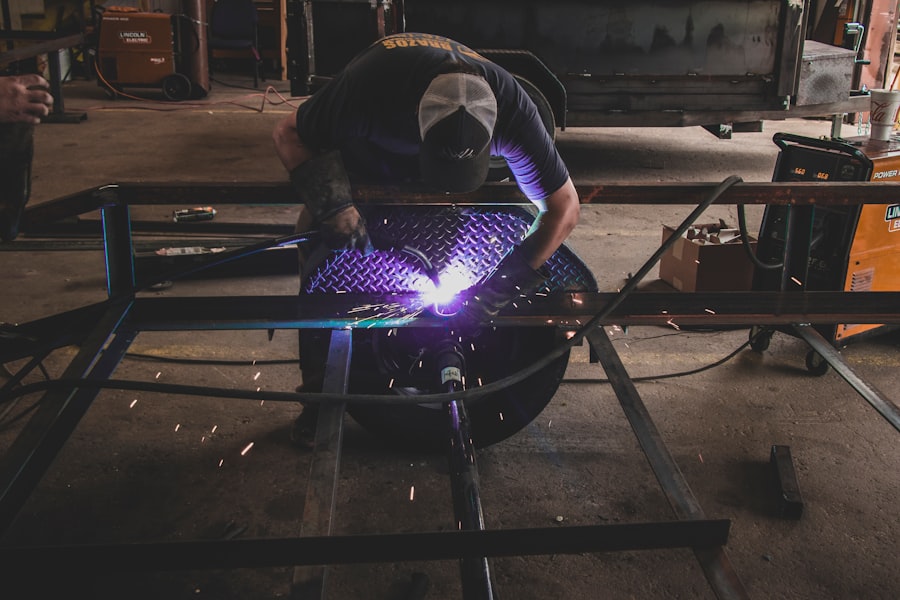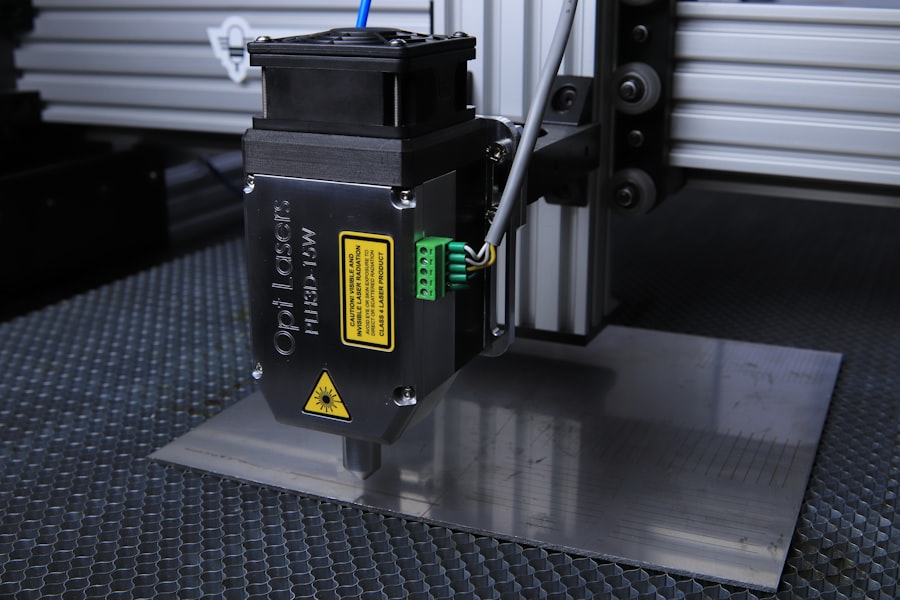Laser hair removal is a popular cosmetic procedure that utilizes concentrated beams of light to target and eliminate unwanted hair. The process begins with the laser emitting a specific wavelength of light that is absorbed by the pigment in the hair follicles. This absorption generates heat, which damages the follicle and inhibits future hair growth.
As you consider this treatment, it’s essential to understand that the effectiveness of laser hair removal largely depends on the contrast between your skin tone and hair color. Darker hair on lighter skin tends to yield the best results, as the laser can easily differentiate between the pigment in the hair and the surrounding skin. Before undergoing the procedure, you will typically have a consultation with a qualified technician or dermatologist.
During this meeting, they will assess your skin type, hair color, and medical history to determine if you are a suitable candidate for laser hair removal. They will also explain the technology used, the expected outcomes, and any potential risks involved. Understanding this process can help alleviate any concerns you may have and prepare you for what lies ahead.
It’s crucial to have realistic expectations; while many people experience significant hair reduction, complete hair removal is not guaranteed.
Key Takeaways
- Laser hair removal targets hair follicles with concentrated light to inhibit future hair growth
- Factors affecting the number of sessions needed include hair color, skin color, and hair thickness
- Recommended number of sessions varies by body area, with 6-8 sessions for the face and 8-12 sessions for the back and chest
- Prepare for laser hair removal by avoiding sun exposure and shaving the treatment area
- During and after each session, expect mild discomfort and temporary redness or swelling
- Maximize effectiveness by following pre and post-care instructions and avoiding plucking or waxing between sessions
- Potential risks and side effects include skin irritation, pigment changes, and rare scarring
- Long-term maintenance may require occasional follow-up sessions to target any regrowth
Factors Affecting the Number of Sessions Needed
The number of laser hair removal sessions you will need can vary significantly based on several factors. One of the primary considerations is your hair growth cycle. Hair grows in three phases: anagen (growth), catagen (transitional), and telogen (resting).
Laser hair removal is most effective during the anagen phase when the hair is actively growing. Since not all hairs are in the same phase at any given time, multiple sessions are necessary to target all hairs effectively. Another factor influencing the number of sessions is your individual hair characteristics.
The thickness, density, and color of your hair can all play a role in how many treatments you will require. For instance, coarse, dark hair typically responds better to laser treatment than fine or light-colored hair. Additionally, hormonal factors can affect hair growth patterns, particularly in areas like the face or underarms.
If you have hormonal imbalances, you may find that you need more sessions to achieve your desired results.
Recommended Number of Sessions for Different Body Areas

When it comes to laser hair removal, different body areas may require varying numbers of sessions for optimal results. For instance, smaller areas such as the upper lip or chin may only need about 4 to 6 sessions spaced several weeks apart. These areas often have less dense hair growth and can respond quickly to treatment.
On the other hand, larger areas like the legs or back may require 6 to 10 sessions or more due to the increased volume of hair and larger surface area being treated. It’s also important to consider that some areas may have different growth rates. For example, underarm hair tends to grow more quickly than leg hair, which might necessitate more frequent treatments in that area.
Your technician will tailor a treatment plan based on your specific needs and goals, ensuring that you receive the most effective care possible. By understanding these recommendations, you can better prepare for your laser hair removal journey.
How to Prepare for Laser Hair Removal Sessions
| Preparation Tips for Laser Hair Removal Sessions |
|---|
| 1. Avoid sun exposure for at least 2 weeks before the session |
| 2. Shave the treatment area the day before the session |
| 3. Avoid using any self-tanning products |
| 4. Inform your technician about any medications you are taking |
| 5. Avoid waxing, plucking, or electrolysis for at least 6 weeks before the session |
| 6. Cleanse the treatment area thoroughly before the session |
Preparation is key to ensuring a successful laser hair removal experience. Before your first session, it’s essential to avoid sun exposure for at least two weeks prior to treatment. Tanning can increase the risk of side effects and reduce the effectiveness of the laser.
If you have recently tanned or have sunburned skin, it’s advisable to reschedule your appointment until your skin has returned to its normal state. Additionally, you should refrain from waxing or plucking hairs for at least four weeks before your session. These methods remove the hair from the follicle, which is counterproductive to laser treatment since the laser needs a target to effectively destroy the follicle.
Shaving is generally acceptable and often recommended as it leaves the follicle intact while removing surface hair. Lastly, consult with your technician about any medications or skincare products you are using, as some may need to be paused before treatment.
What to Expect During and After Each Session
During your laser hair removal session, you can expect a quick and relatively painless experience. Most modern lasers come equipped with cooling devices that help minimize discomfort during treatment. You may feel a slight snapping sensation as the laser targets each follicle, but this is typically well-tolerated by most individuals.
The duration of each session will depend on the size of the area being treated; smaller areas may take just a few minutes, while larger areas could take up to an hour. After each session, it’s common to experience some redness and swelling in the treated area, similar to a mild sunburn. This usually subsides within a few hours but can last up to a couple of days for some individuals.
Your technician will provide aftercare instructions, which may include applying soothing creams or avoiding sun exposure for a short period. It’s essential to follow these guidelines closely to ensure optimal healing and results.
Tips for Maximizing the Effectiveness of Laser Hair Removal

To maximize the effectiveness of your laser hair removal treatments, there are several strategies you can employ. First and foremost, adhere strictly to your treatment schedule as recommended by your technician. Consistency is crucial for achieving optimal results since each session builds upon the last by targeting hairs in different growth phases.
Additionally, maintaining healthy skin can enhance your results. Hydrate adequately and use gentle skincare products that do not irritate your skin before and after treatments.
Lastly, consider discussing any lifestyle changes with your technician that could impact hair growth, such as changes in diet or hormonal treatments.
Potential Risks and Side Effects of Laser Hair Removal
While laser hair removal is generally considered safe, it does come with potential risks and side effects that you should be aware of before proceeding with treatment.
In rare cases, individuals may experience blistering or changes in skin pigmentation, particularly if they have darker skin tones or have not followed pre-treatment guidelines.
It’s crucial to choose a qualified technician who uses FDA-approved equipment and follows safety protocols to minimize these risks. During your consultation, don’t hesitate to ask about their experience and any safety measures they implement during treatments. Being informed about potential side effects can help you make an educated decision about whether laser hair removal is right for you.
Long-Term Maintenance and Follow-Up Sessions
After completing your initial series of laser hair removal sessions, you may find that some fine hairs still persist in certain areas. This is normal and can be addressed through maintenance sessions as needed. Many individuals opt for follow-up treatments once or twice a year to maintain their results and ensure that any regrowth is managed effectively.
Long-term maintenance not only helps keep unwanted hair at bay but also allows you to enjoy smoother skin without the hassle of traditional hair removal methods like shaving or waxing. Your technician will work with you to develop a personalized maintenance plan based on your individual needs and goals. By committing to these follow-up sessions, you can enjoy lasting results from your laser hair removal journey while minimizing any future regrowth.
In conclusion, understanding the intricacies of laser hair removal can empower you as you embark on this journey toward smoother skin. From grasping how the process works to knowing what factors influence treatment frequency and how to prepare effectively, being informed will enhance your overall experience. By following recommended guidelines and maintaining open communication with your technician, you can achieve optimal results while minimizing risks associated with this popular cosmetic procedure.
If you are considering laser hair removal, you may be wondering how many sessions you really need to achieve the desired results. According to a related article on In Laser Hair Removal, the number of sessions required can vary depending on factors such as hair color, skin tone, and the area being treated. It is important to consult with a professional to determine the best treatment plan for your specific needs.
FAQs
What is laser hair removal?
Laser hair removal is a cosmetic procedure that uses a concentrated beam of light (laser) to remove unwanted hair. The laser targets the pigment in the hair follicles, damaging them and inhibiting future hair growth.
How many laser hair removal sessions do you really need?
The number of laser hair removal sessions needed varies depending on factors such as the individual’s hair type, skin color, and the area being treated. On average, most people require 6-8 sessions spaced 4-6 weeks apart to achieve optimal results.
Why do multiple sessions of laser hair removal treatment necessary?
Multiple sessions of laser hair removal are necessary because hair grows in different stages and the laser can only effectively target hair in the active growth phase. Multiple sessions ensure that all hair follicles are treated during their active growth phase, leading to long-term hair reduction.
Are touch-up sessions required after completing the initial laser hair removal sessions?
After completing the initial series of laser hair removal sessions, some individuals may require occasional touch-up sessions to maintain the results. The need for touch-up sessions varies from person to person and depends on factors such as hormonal changes and individual hair growth patterns.
What areas of the body can be treated with laser hair removal?
Laser hair removal can be used to treat unwanted hair on various areas of the body, including the face, legs, arms, underarms, bikini line, and back. It is important to consult with a qualified practitioner to determine the suitability of laser hair removal for specific areas.




